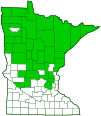marsh grass of Parnassus
(Parnassia palustris)
Conservation • Wetland • Description • Habitat • Ecology • Use • Distribution • Taxonomy
Description |
||
Marsh grass of Parnassus is a 8″ to 16″ tall, erect, perennial forb that rises from a short, thickened, underground stem (caudex) and fibrous roots. Basal leaves are on long leaf stalks and form a rosette. The leaf stalks are 1½ to 4 times as long as the blades. The blades are stiff, leathery, hairless, broadly egg-shaped to almost circular, 1⅛″ to 2″ long, and ⅝″ to 1¾″ wide. They are ¾ to fully as wide as they are long. The base is usually heart-shaped, sometimes broadly rounded. The blade does not extend down the leaf stalk below the point of attachment. The margins are untoothed. A single, unbranched, hairless, 8″ to 16″ long flowering stalk (scape) rises from the rosette of basal leaves. There is usually a single leaf-like bract at or well below the middle of the stem. The bract is stalkless but otherwise similar to and the same size as basal leaves. The blade is broadly egg-shaped. It is heart-shaped at the base, and clasps the stem at the base. The inflorescence is a single flower held erect at the end of the stem. The flowers are ¾″ to 1½″ wide. Each flower has 5 green sepals and 5 white petals. The sepals are ⅛″ to 7 ⁄16″ long and elliptic. The petals are narrowly to broadly egg-shaped, ⅜″ to ½″ long, 1½ to 2 times as long as the sepals. Each petal has 5 to 17 greenish-yellow veins. The 5 center veins are usually unbranched. There are 5 white stamens with brown anthers. There are also 5 white sterile stamens (staminodes) that are divided into 9 to 23 slender filaments for 3 ⁄5 or 4 ⁄5 of their length. Each filament is green or yellow, 3 ⁄16″ to ⅜″ long, and topped with a modified anther reduced to a gland. The staminodes are a little shorter than the stamens. The fruit is a 4-valved, egg-shaped, 5 ⁄16″ to ½″ long capsule with numerous seeds. |
||
Height |
||
8″ to 16″ |
||
Flower Color |
||
White with dark green veins |
||
Similar Species |
||
Fen grass of Parnassus (Parnassia glauca) has a smaller bract, smaller than the basal leaves. The bract does not clasp the stem. The staminodes are white, and are divided near the tip into 3 filaments. |
||
Habitat |
||
Wet; meadows, shores rich in lime. |
||
Ecology |
||
Flowering |
||
July to August |
||
Pests and Diseases |
||
|
||
Use |
||
|
||
Distribution |
||||
|
Sources |
|||
| 4/16/2023 | ||||
Nativity |
||||
Native |
||||
Occurrence |
||||
Fairly common |
||||
Taxonomy |
|||
| Kingdom | Plantae (Plants) | ||
| Division | Tracheophyta (Vascular Plants) | ||
| Subdivision | Spermatophytina (Seed Plants) | ||
| Class | Magnoliopsida (Dicots) | ||
Order |
Celastrales (staff-vines and allies) | ||
Family |
Celastraceae (staff-vine) | ||
| Subfamily | Parnassioideae | ||
| Tribe | Parnassieae | ||
Genus |
Parnassia (grass of Parnassus) | ||
Subordinate Taxa |
|||
GBIF recognizes seven varieties. Four of these occur in North America and one occurs in Minnesota. USDA PLANTS recognizes four varieties in North America. Two of these occur in Minnesota. GRIN and ITIS recognize no varieties. Plants of the World Online recognizes three varieties. Only the nominate variety, Parnassia palustris var. palustris occurs in North America. World Flora Online recognizes one subspecies and two varieties, none of which occur in North America. Presumably, only the unlisted nominate species occurs in North America. Flora of North America (FNA) mentions the profusion of varieties that have been described in Eurasia and North America, but does not formally recognize them. |
|||
Alaska grass of Parnassus (Parnassia palustris var. palustris) grass of Parnassus (Parnassia palustris var. condensata) grass of Parnassus (Parnassia palustris var. izuinsularis) grass of Parnassus (Parnassia palustris var. yakusimensis) grass of Parnassus (Parnassia palustris ssp. pseudoalpicola) marsh grass of Parnassus (Parnassia palustris var. tenuis) mountain grass of Parnassus (Parnassia palustris var. montanensis) small-flowered grass of Parnassus (Parnassia palustris var. parviflora) |
|||
Synonyms |
|||
Parnassia californica Parnassia montanensis Parnassia multiseta Parnassia palustris ssp. neogaea Parnassia palustris var. californica Parnassia palustris var. neogaea |
|||
Common Names |
|||
Arctic grass-of-Parnassus bog-star bog stars marsh grass-of-Parnassus marsh grass of Parnassus northern grass-of-Parnassus northern grass of Parnassus |
|||
Glossary
Bract
Modified leaf at the base of a flower stalk, flower cluster, or inflorescence.
Caudex
A short, thickened, woody, persistent enlargement of the stem, at or below ground level, used for water storage.
Clasping
Describing a leaf that wholly or partly surrounds the stem but does not fuse at the base.
Scape
An erect, leafless stalk growing from the rootstock and supporting a flower or a flower cluster.
Sepal
An outer floral leaf, usually green but sometimes colored, at the base of a flower.
Staminode
A modified stamen that produces no pollen. It often has no anther.
Visitor Photos |
|||||
Share your photo of this plant. |
|||||
| This button not working for you? Simply email us at info@MinnesotaSeasons.com. Attach one or more photos and, if you like, a caption. |
|||||
|
|||||
MinnesotaSeasons.com Photos |
|||||
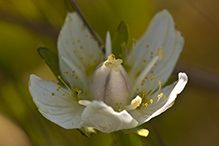 |
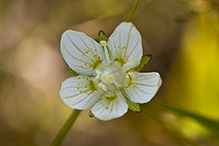 |
||||
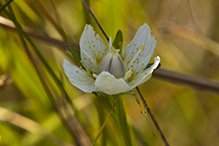 |
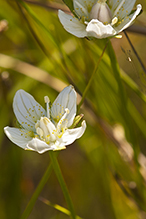 |
||||

Slideshows |
||

Visitor Videos |
|||
Share your video of this plant. |
|||
| This button not working for you? Simply email us at info@MinnesotaSeasons.com. Attach a video, a YouTube link, or a cloud storage link. |
|||
Other Videos |
|||
| Parnassia palustris ΕΛΕΥΘΕΡΙΟΣ ΚΗΠΟΠΟΥΛΟΣ |
|||
About
Published on Sep 28, 2013 A widespread only on mountains in the Mediterranean area. Video was taken on mt Olympus of Greece, in September 2013. |
|||
| Parnassia heliam's channel |
|||
About
Uploaded on Sep 6, 2010 De Parnassia palustris in bloei op natuurterrein Klarenbeek (De Ruige Hof), Amsterdam-Zuidoost. De parnassia is de meest populaire bloem van Noord-Holland. Aan het begin van de clip ziet u het klein geaderd witje, aan het eind de watersnuffel. Steun De Ruige Hof. [taxonomy:common=Marsh Grass-of-Parnassus] |
|||
| Parnassia palustris - Marsh Grass-of-Parnassus dreamshot |
|||
About
Uploaded on Nov 27, 2010 Parnassia (Parnassia palustris) was vroeger in Nederland breed verspreid op de veengronden, zandgronden en in Zuid-Limburg op het krijt. Inmiddels de plant zeldzaam geworden door ontwatering en hogere bemestingsgraad. Parnassia is wettelijk beschermd. Nu groeit ze het meest in vochtige duinvalleien en op drooggevallen zandplaten in afgesloten zeearmen. parnassia -Parnassia palustris - Marsh Grass-of-Parnassus, Northern Grass-of-Parnassus, Bog-star - Parnassie des marais - Sumpf-Herzblatt, Studentenröschen - hepática blanca - Slåtterblomma - Dziewięciornik błotn HD stockshots broadcast format available at: http://www.stockshot.nl/ - |
|||
| Tolije bahenní Parnassia palustris Karel Filip |
|||
About
Published on Sep 15, 2012 Vzácná, mizející a silně ohrožená květina se představuje. |
|||
| 땅끝해남 야생화(12)-물매화 석정주 |
|||
About
Uploaded on Nov 2, 2011 물매화 과 명 : 범의귀과 학 명 : Parnassia palustris Linne 분 포 지 : 전국 개 화 기 : 7~9월 산기슭의 볕이 잘 드는 습지에서 자라는 여러해살이풀이다. 높이 30cm로 뿌리에서 난 잎은 뭉쳐나고 잎자루가 길다. 줄기는 3~4개가 뭉쳐나고 곧게 선다. 꽃은 흰색으로 줄기 끝에 1개씩 하늘을 향해 달린다. 꽃받침잎은 5개이다. 해남지역에서는 11월초까지도 꽃이 핀다. 물매화풀, 풀매화, 매화초, 다자매화초라는 속명을 갖고 있다. 관상용으로 여러 포기를 한꺼번에 심으며 밀원식물이다. 한방에서는 뿌리를 제외한 식물체 전체를 약재로 쓴다. 오영상 기자 desk@hnews.co.kr |
|||

Visitor Sightings |
|||||
Report a sighting of this plant. |
|||||
| This button not working for you? Simply email us at info@MinnesotaSeasons.com. Be sure to include a location. |
|||||
|
|||||
MinnesotaSeasons.com Sightings |
|||||

|
Created: Last Updated: © MinnesotaSeasons.com. All rights reserved. |
